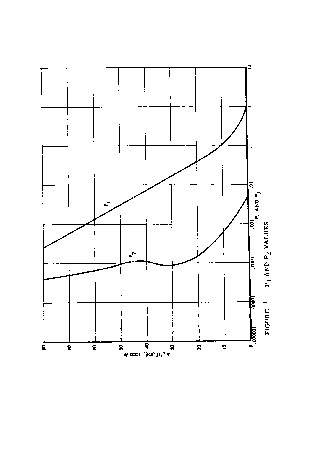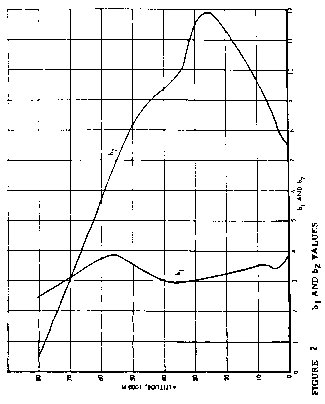Federal Aviation Regulations
Appendix G to Part 25 — Continuous Gust Design Criteria
The continuous gust design criteria in this appendix must be used in establishing the dynamic response of the airplane to vertical and lateral continuous turbulence unless a more rational criteria is used. The following gust load requirements apply to mission analysis and design envelope analysis:(a) The limit gust loads utilizing the continuous turbulence concept must be determined in accordance with the provisions of either paragraph (b) or paragraphs (c) and (d) of this appendix.
(b) Design envelope analysis. The limit loads must be determined in accordance with the following:
(1) All critical altitudes, weights, and weight distributions, as specified in §25.321(b), and all critical speeds within the ranges indicated in paragraph (b)(3) of this appendix must be considered.
(2) Values of Ā (ratio of root-mean-square incremental load root-mean-square gust velocity) must be determined by dynamic analysis. The power spectral density of the atmospheric turbulence must be as given by the equation—
where:
φ=power-spectral density (ft./sec.)2 /rad./ft.
σ=root-mean-square gust velocity, ft./sec.
Ω=reduced frequency, radians per foot.
L=2,500 ft.
(3) The limit loads must be obtained by multiplying the Ā values determined by the dynamic analysis by the following values of the gust velocity U
(i) At speed Vc: U
(1) The transfer function of the new design should exhibit no unusual characteristics as compared to the similar design which will significantly affect response to turbulence; e.g., coalescence of modal response in the frequency regime which can result in a significant increase of loads.
(2) The typical mission of the new airplane is substantially equivalent to that of the similar design.
(3) The similar design should demonstrate the adequacy of the U
(ii) At speed VB: U
(iii) At speed VD: U
(iv) At speeds between VBand Vcand between Vcand VD: U
(4) When a stability augmentation system is included in the analysis, the effect of system nonlinearities on loads at the limit load level must be realistically or conservatively accounted for.
(c) Mission analysis. Limit loads must be determined in accordance with the following:
(1) The expected utilization of the airplane must be represented by one or more flight profiles in which the load distribution and the variation with time of speed, altitude, gross weight, and center of gravity position are defined. These profiles must be divided into mission segments or blocks, for analysis, and average or effective values of the pertinent parameters defined for each segment.
(2) For each of the mission segments defined under paragraph (c)(1) of this appendix, values of Ā and Nomust be determined by analysis. Ā is defined as the ratio of root-mean-square incremental load to root-mean-square gust velocity and Nois the radius of gyration of the load power spectral density function about zero frequency. The power spectral density of the atmospheric turbulence must be given by the equation set forth in paragraph (b)(2) of this appendix.
(3) For each of the load and stress quantities selected, the frequency of exceedance must be determined as a function of load level by means of the equation—
where—
t=selected time interval.
y=net value of the load or stress.
Y
N(y)=average number of exceedances of the indicated value of the load or stress in unit time.
No, Ā=parameters determined by dynamic analysis as defined in paragraph (c)(2) of this appendix.
P1, P2, b1, b2=parameters defining the probability distributions of root-mean-square gust velocity, to be read from Figures 1 and 2 of this appendix.
The limit gust loads must be read from the frequency of exceedance curves at a frequency of exceedance of 2×10−5 exceedances per hour. Both positive and negative load directions must be considered in determining the limit loads.
(4) If a stability augmentation system is utilized to reduce the gust loads, consideration must be given to the fraction of flight time that the system may be inoperative. The flight profiles of paragraph (c)(1) of this appendix must include flight with the system inoperative for this fraction of the flight time. When a stability augmentation system is included in the analysis, the effect of system nonlinearities on loads at the limit load level must be conservatively accounted for.
(d) Supplementary design envelope analysis. In addition to the limit loads defined by paragraph (c) of this appendix, limit loads must also be determined in accordance with paragraph (b) of this appendix, except that—
(1) In paragraph (b)(3)(i) of this appendix, the value of U
(2) In paragraph (b) of this appendix, the reference to paragraphs (b)(3)(i) through (b)(3)(iii) of this appendix is to be understood as referring to the paragraph as modified by paragraph (d)(1).
 View or download PDF
View or download PDF View or download PDF
View or download PDF[Amdt. 25–54, 45 FR 60173, Sept. 11, 1980]
NEXT: Appendix H to Part 25 - Instructions for Continued Airworthiness
PREVIOUS: Sec. 25.1733 - Fire detector systems, general: EWIS.
